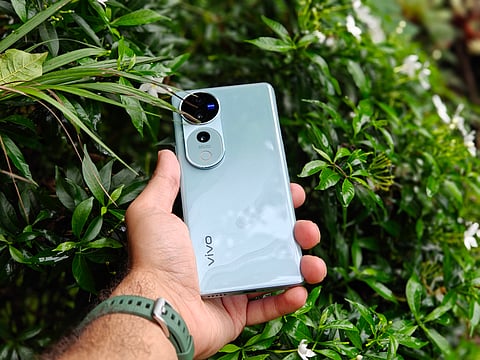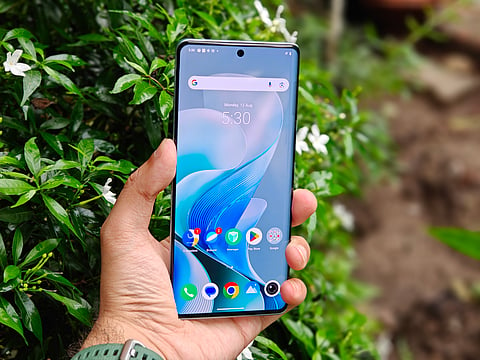These are the exact words I muttered to a friend at the launch of the Vivo V40 Pro a few days ago, “Cheaper than the Honor 200 Pro and better than the Xiaomi 14 Civi”. It’s been a few days of digesting that sentence and I still stand by it.
Vivo V40 Pro review: The best mid-range smartphone for its camera chops?
Cheaper than the Honor 200 Pro and better than the Xiaomi 14 Civi. With stellar portraits (with ZEISS optics) and a superb chipset, the Vivo V40 Pro is the top contender in the mid-range segment
It’s been about two years since I’ve properly tested a Vivo smartphone and I am impressed. It’s not a perfect smartphone (read: bloatware), but with a great design, insanely good portraits and solid battery life, I’m giving the Vivo V40 Pro two thumbs up. Let me tell you why in detail.

What is the Vivo V40 Pro
The Vivo V40 Pro debuts barely a few months after the V30 Pro. With it comes stereo speakers, a better IP rater, a bigger battery, ZEISS-backed cameras, MediaTek Dimensity 9200+ SOC, and a higher starting price (increase of Rs 10,000) of Rs 49,999.
Display: 6.78-inch FHD+ AMOLED (120Hz refresh rate and a peak brightness of 4,500 nits).
Display resolution: 1260 x 2800 pixels
SoC: MediaTek Dimensity 9200+
RAM: Up to 12GB
Storage: Up to 512GB
Cameras: 60MP main camera (with Optical Image Stabilisation), 50MP ultra-wide camera and a 50MP 2x telephoto sensor
Battery: 5,500mAh
Charging support: 80W wired charging
Thickness: 7.5mm
Weight: 192g
IP rating: IP68
Price: Rs 49,999 for the 8GB/256GB variant.
Colour options: Ganges Blue and Titanium Grey
What stands out
There are three areas in which the Vivo V40 Pro shines; design, performance and cameras. Design has been paramount for Vivo with their V-series smartphones. For Vivo, it’s one way to stand out in a crowded market.
Dare I say it, but the Ganges Blue variant of the V40 Pro looks eerily similar to the Honor 200 Pro that launched a few weeks prior. The V40 Pro sports a pill-shaped camera on the back, something I can get on board with. It’s a new approach from Vivo and is sure to be eye-catching. Vivo is calling this the Infity Eye Camera Module design (pendulum-shaped).
There are two cameras in the top circular module with the third camera and the Aura LED ring housed inside the bottom module.
The front, and back glass panels curve at the edges. The Ganges Blue variant gets a glossy back and looks out of the ordinary. If you prefer a more subtle design then you’re better off with the Titanium Grey variant.

The V40 Pro comes with a 6.78-inch AMOLED display. It’s plenty bright for some outdoor fun. The display has great viewing angles, looks good on the eye and has bright and vibrant colours. I watched a few Olympic wrestling bouts on the V40 Pro and had a good experience. The V40 Pro has a “Comprehensive Cusionhing Structure” for improved durability. Furthermore, it has Schott Alpha glass on the front for protection. This means it can withstand drops. There’s also the reinforced frame.
The Ganges Blue variant I received for review is a little bit slippery. I’d suggest you put a case on this, even though it’ll take away, from that eye-catching design. A simple clear case comes in the box. The V40 Pro comes with an IP68 rating (hallelujah), a big improvement from the V30 Pro’s IP54 rating.
There’s an in-display fingerprint sensor that is fairly fast and accurate.
Performance: The V40 Pro is the MediaTek Dimensity 9200+ SoC launch device in India. The V-series is finally rocking a flagship (albeit an older generation flagship) SoC and I couldn’t be happier. What changes is not the day-to-day performance, which is excellent, but that of gaming. One can now finally game, without feeling left behind, on the V40 Pro. While playing Call of Duty: Mobile on medium-quality settings, I was constantly getting over 100fps. Now that’s quite impressive.
I can safely say that this is one of the fastest smartphones in this price segment. It’s faster than a lot of those Snapdragon 8s Gen 3-powered smartphones. It’s a massive upgrade from the V30 Pro and outshines the likes of the Xiaomi 14 Civi.
The V40 Pro was extremely smooth, with fluid animations, and hardly any lag. I constantly had 5-6 apps in the background and over 30 tabs on Google Chrome, and the phone never slowed down. It did get warm while gaming, but a software update has fixed that issue.
Stereo speakers: Thankfully Vivo has listened to customer feedback and included stereo speakers in the V40 Pro. They are loud and pretty clear. Not the best in the business, but a huge upgrade from the V30 Pro. I’m a happy camper.
Cameras: This is what impressed me the most on the V40 Pro. The V40 Pro gets the Sony IMX921 main sensor as opposed to the V30 Pro which had the Sony IMX 920. That change itself makes the camera that much better. Many reviewers praised the V30 Pro’s camera, and in my brief time with it, I also found it to be good. The V40 Pro is just better, in every which way.
Vivo didn’t really have to change the game here, and that’s a good thing. The 50MP (Sony IMX816) portrait lens comes with support for 2x optical zoom and even 50x digital zoom (though you won’t want to use it much). All four cameras, including the 50MP front camera, are backed by ZEISS. Having this partnership with ZEISS means that the V40 Pro can now offer Multifocal Portrait photography with options for 24mm, 35mm, 50mm, 85mm and 100mm. There are also plenty of ZEISS portrait styles - Biotar, B-Speed, Planar, Cine-flare, and more - that you’d want to use.
Right off the bat, there was something I noticed. Vivo has managed to get the colours to match between the lenses. That’s something that a lot of the competitors in this range have failed to do The primary camera captures sharp and detailed images, though it takes a few seconds to process. The white balance is good and there is a lot of dynamic range. You get options for VIvid, Textured and ZEISS Natural in the photo mode. The default is Vivid. For the most part, I settled for Vivid, as the colours in the photos were bright and punchy.
Yes, some of the colours are boosted and not as natural looking as Xiaomi 14 Civi.
Portrait mode, just like with the Honor 200 Pro, is the USP of this smartphone. As I said above, you can choose between different focal lengths. You can also choose to delve into the “Portrait lens kit” which has some presets for your convenience. There’s “35mm Street portrait”, “50mm Classic portrait” or “100mm Close-up” and more.
There are plenty of “bokeh” options as well, most of which were fun to play around with. One thing I didn’t like was the “Beauty” options as they would over-sharpen the images, and smoothen out the skin. I’d rather the portrait end up looking more natural.
In low-light scenarios, the camera performed well. The images were a little soft and lost some details, but were more than just usable. It’s in those absolute dark moments where the camera falls apart (unlike its more expensive siblings, the X100 and X100 Pro). In scenarios where there was just no light, the night mode would work overtime to produce something bright. That bright photo tended to look very unnatural.
The ultra-wide lens was pretty good though again, it was the lens that captured the least details. Still, with a 15mm-equivalent field of view, along with autofocus, this lens was good for taking landscapes.
Selfies were one of the best of any mid-range smartphone. It has autofocus and a wide-selfie, so everyone is happy. It does take a few seconds to process, but the results are stellar.
All-in-all, the V40 Pro camera was a delight to play around with. I found myself taking 100s of portraits in a single sitting at a bar. That’s something I don’t say for a lot of other smartphone cameras.
Battery: The V40 Pro houses a 5,500mAh battery, an improvement from the V30 Pro’s 5,000mAh battery. The increase in battery capacity means that the V40 Pro comfortably lasts a whole day even with a heavy-usage cycle. I never got less than 5 percent before hitting the sack. Even that was after an intense day of clicking photos, playing games, bingeing on the Olympics and more. There is an 80W charger included in the box.The device can go from 20 to 100 percent in just 40 minutes. A full charge, from nought to 100, takes about an hour.
What I didn’t like
Software: Bloatware. That’s the one-word review of Functoch OS 14 (based on Android) that the smartphone comes with. Bloatware and ads. Simply put, a lot of this is unnecessary in a mid-range smartphone. When you boot up the smartphone, you’re greeted with folders full of pre-installed apps and games that you probably wouldn’t be downloading in the first place. Most of them can be removed, but some just can’t. It’s a time-consuming and frankly annoying task.
Once you get into the groove of using the smartphone, there’ll be a bevvy of notifications from Vivo’s very own first-party apps. Again, most can be disabled, but also, they can’t be uninstalled.
One last note on the software front. Vivo is providing just two OS updates and three years of security patches. That’s one step behind some of the competitors.
Final verdict: The best mid-range smartphone out there
What I really want is for Vivo to overhaul its software. Yes, there is a lot of customisation, and the OS is easy to navigate, but the amount of bloatware and unnecessary notifications gets to you quickly.
The smartphone is priced at Rs 49,999 (though I’d wait for a discount to snag one), much higher than the V30 Pro. For the most part, it is justified. There’s the fantastic performance (yes, you can game on this smartphone), a much-improved IP rating, stereo speakers (bingeing on the Olympics was fun), and those stellar cameras. It’s also got a lot of AI features, which I didn’t even get to touch upon in this review.
The speakers aren’t the best in the business (though an improvement from the V30 Pro). Yes, the pricing might deter some buyers, especially when the Xiaomi 14 Civi, Realme GT 6 and other smartphones are cheaper. Still, I stand by what I said at the beginning. The V40 Pro is cheaper than the Honor 200 Pro and better than the Xiaomi 14 Civi.
Buy it for the cameras, and be pleasantly surprised with its performance.